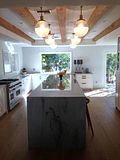Don't worry. I have not forgotten that I skipped your history lesson last week. I am here to remedy the situation.
I know all of you out there know what a traditional Chippendale chair looks like...carved cabriole leg, intricate backsplat. In fact, many of you (Mom) have Chippendale chairs around your dining room table. Some variations are shown below.
Enter the Chinese Chippendale. I found an article from House Beautiful that does a wonderful job describing the Chinese Chippendale:

Chinese Chippendale, that gorgeous by-product of a 1741 travel book, was "invented" by English furniture designer Thomas Chippendale (the first nonmonarch to have a style named for him). The craze it created in mid-18th-century England prompted an aggrieved critic to write: "So universally has it spread, that every gate to a cow-yard is in T's and Z's." And while Chinese Chippendale is just a frothy side trip on the long march of decor, its pagodas and fretwork, bamboo and bells live on in our own chairs (and beds, and mirrors, and wallpaper, and tables) today. We love it on anything. If only we still kept cows.
Was Chinese Chippendale furniture actually made in China? And what's the difference between it and regular Chippendale?
Thomas Chippendale was already famous for his elegant mahogany furniture when he applied the newly popular chinoiserie to his quintessentially English wares. And while, for economy's sake, he might have preferred to have them made in the Far East, in 1750s London, little but lacquer and porcelain "smalls" were being shipped from China.
What's the difference between Chinese and Chinese Chippendale furniture?
Early Chinese furniture is austere, boldly linear with not much carving. Chinese Chippendale designs are madly rococo, embellished with all sorts of architectural details from temples, palaces, and pavilions. Some are more successful than others. All of it is "busy."
But some of the things I see in stores look fairly restrained.
Mid-18th-century furnishings were so fancy and ubiquitous that in 1756, one waspish observer wrote, "Every chair in an apartment, the frames of [looking] glasses and tables must be Chinese: the walls covered with Chinese paper filled with figures which resemble nothing in God's creation, and which a prudent nation would prohibit for the sake of pregnant women." The more restrained designs you're seeing are generally later takes on the whimsical furnishings of the Brighton Pavilion, an exotic early-19th-century palace built for the Prince of Wales.
Is Chinese Chippendale more expensive than plain furniture?
Usually. Every step added to the furniture-making process makes the finished product more expensive. A pagoda pediment on a mirror, tiny bells dangling on corners, carved herons, or lots of latticework make any piece — old or new — pricier.
KEEP AN EYE OUT FOR:
- Older reproductions, manufactured from the 1870s on. More recent pieces, especially those without labels, can be painted — with removable paints, since we ought to think of future generations!
- Early-19th-century Brighton Pavilion pieces incorporating brilliantly lacquered faux-bamboo elements, lotus-like designs, or palm tree motifs. These are usually quite costly.
- Lots of detail and plenty of bells and whistles. All things being equal, armchairs will be more expensive than side chairs.
- Those dazzlingly hued (chartreuse, orange, stark white) reproductions from the 1960s, which were popular in resort areas.
STAY AWAY FROM:
- Damaged lacquer — a really difficult repair — and badly chipped paint.
- Clumsily executed carvings.
- Missing elements of fretwork or carving.
- Repainted anything.































No comments:
Post a Comment